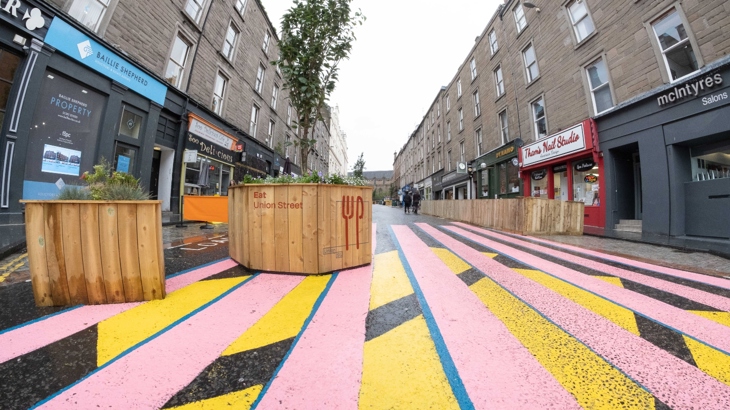Research by Sustrans has revealed the benefits of the temporary changes to Scotland’s walking and cycling infrastructure, introduced during the 2020 Covid lockdown.

Union Street in Dundee, following the installation of seating, planters and street art. Credit: Paul Reid/Sustrans
Launched in May 2020, Spaces for People provided emergency funding to local authorities, transport partnerships and health boards.
The funding was made available to create spaces for people to physically distance during the pandemic and to improve road safety for people walking, wheeling and cycling.
An initial evaluation of the measures which were put in place has revealed:
- a 25% increase in pedestrian use where Spaces for People measures (such as pavement widening) were introduced, compared with control sites
- 50% of local people support the 20mph limits introduced in Perth & Kinross, Dundee, Stirling and Angus, whilst a further 27% feel neutrally about them.
- 48% of survey respondents in Perth & Kinross, Dundee, Stirling and Angus reported an increase in the time they spend walking for leisure and exercise.
- 94% of survey respondents in Aberdeen City agreed that the Spaces for People measures have made it easier to walk or cycle.
- 2 million people live within ten minutes’ walk of Spaces for People measures
- 178 interventions were installed within the first two months of the programme and 316 were installed by the end of the first six months
Working to make measures permanent
With all funds allocated, the programme now funds on-going maintenance, monitoring and work to remove or make permanent various measures.
Projects funded by Spaces for People include:
- the opening of Kelvin Way, Glasgow, to walking, wheeling and cycling
- the installation of seating, planters and street art on Union Street, Dundee
- the installation of seating areas in Aberdeen, designed in partnership with the local access forum
- the implementation of widened footways in Inverness
- the introduction of speed reduction zones in 272 locations across Scotland, including 90 zones in towns and villages in the Scottish Borders.
A real appetite for walking, wheeling and cycling
Scotland’s Active Travel Minister Patrick Harvie said:
“When the pandemic struck last year it changed overnight how we thought about travel.
"Both in how far we could go and how we travel.
"It showed a real appetite for people to walk, wheel and cycle more.
"So the speed and breadth of change that was delivered by many councils, Sustrans and other delivery partners to create safe spaces in our towns and cities, was so important in meeting that new demand.
“I’m pleased at the positive findings coming out from Sustrans' initial report on Spaces for People and look forward to the full report being published next year.
"It shows that if safe space is provided, people want to use it.”
Helping people to stay safe and active
Karen McGregor, Director of Capital Programmes for Sustrans Scotland, said:
“Spaces for People was created to help people stay safe and active in their local area during the pandemic.
"We are pleased to see that measures created by councils and health boards across Scotland helped to encourage people to make use of their space, complete their local journeys and socialise safely.”
The findings have come from Sustrans Scotland’s work collating evidence for a final report to be published in the summer of 2022.
This is being done to evaluate the Spaces for People measures, with monitoring carried out by Sustrans, local authorities and third-parties such as engineering firms and specialist researchers.
The majority of measures have been introduced for a period of up to 18 months, with the option for them to become permanent following consultation with local communities and the processing of a traffic regulation order.
While some Spaces for People measures were removed as lockdowns eased and road traffic increased, more than 50% of projects are expected to go through a public consultation process to gauge support for permanent measures.





